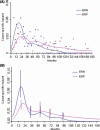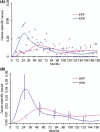Recurrence and mortality dynamics for breast cancer patients undergoing mastectomy according to estrogen receptor status: different mortality but similar recurrence
- PMID: 20132222
- PMCID: PMC11159972
- DOI: 10.1111/j.1349-7006.2009.01472.x
Recurrence and mortality dynamics for breast cancer patients undergoing mastectomy according to estrogen receptor status: different mortality but similar recurrence
Abstract
(Cancer Sci 2010; 101: 826-830) The purpose was to ascertain whether the recurrence risk patterns for patients with estrogen receptor (ER)-positive (P) and ER-negative (N) breast cancer support the ER-related clinical divergence suggested by the observed different mortality patterns and gene expression profiles. Both recurrence and death were considered in a series of 771 patients undergoing mastectomy. ER status was available for 539 patients. The hazard rates for recurrence and mortality throughout 15 years of follow-up were assessed. The recurrence dynamics displays a bimodal pattern for both ERP and ERN tumors with comparable peak timings. The two curves cross during the 3rd year. By contrast, the mortality dynamics are definitely different for ERP and ERN tumors: during the early follow-up period ERN patients have their highest mortality risk, while ERP patients have their lowest mortality risk. The two curves cross during the 5th year. In spite of the different mortality dynamics, the recurrence dynamics do not demonstrate a major distinction in timing between ERP and ERN breast cancers, suggesting that the metastasis development process following mastectomy is apparently similar for both ER categories. The observed differences in the mortality risk are plausibly attributable to ER-related factors influencing the clinical course from recurrence to death. These clinical findings apparently contradict the occurrence of two different types of breast cancer, notwithstanding the distinct epidemiological, clinical, and molecular features linked to ERP and ERN tumors, although ER levels may concur to establish the event risk levels.
Figures


Similar articles
-
Recurrence and mortality according to estrogen receptor status for breast cancer patients undergoing conservative surgery. Ipsilateral breast tumour recurrence dynamics provides clues for tumour biology within the residual breast.BMC Cancer. 2010 Nov 30;10:656. doi: 10.1186/1471-2407-10-656. BMC Cancer. 2010. PMID: 21118508 Free PMC article.
-
Estrogen receptor protein of breast cancer as a predictor of recurrence.Cancer. 1985 Mar 15;55(6):1178-81. doi: 10.1002/1097-0142(19850315)55:6<1178::aid-cncr2820550606>3.0.co;2-u. Cancer. 1985. PMID: 3971291
-
Estrogen/progesterone receptor negativity and HER2 positivity predict locoregional recurrence in patients with T1a,bN0 breast cancer.Int J Radiat Oncol Biol Phys. 2010 Aug 1;77(5):1296-302. doi: 10.1016/j.ijrobp.2009.12.011. Epub 2010 May 14. Int J Radiat Oncol Biol Phys. 2010. PMID: 20472353
-
Local recurrence of mammary Paget's disease after nipple-sparing mastectomy and implant breast reconstruction: a case report and literature review.World J Surg Oncol. 2022 Sep 6;20(1):285. doi: 10.1186/s12957-022-02746-4. World J Surg Oncol. 2022. PMID: 36064544 Free PMC article. Review.
-
The nature of tamoxifen action in the control of female breast cancer.In Vivo. 2001 Jul-Aug;15(4):319-25. In Vivo. 2001. PMID: 11695224 Review.
Cited by
-
Pattern of recurrence of early breast cancer is different according to intrinsic subtype and proliferation index.Breast Cancer Res. 2013;15(5):R98. doi: 10.1186/bcr3559. Breast Cancer Res. 2013. PMID: 24148581 Free PMC article.
-
Differences in metastatic patterns in relation to time between primary surgery and first relapse from breast cancer suggest synchronized growth of dormant micrometastases.Breast Cancer Res Treat. 2014 Aug;146(3):627-36. doi: 10.1007/s10549-014-3057-9. Epub 2014 Jul 20. Breast Cancer Res Treat. 2014. PMID: 25038878 Free PMC article.
-
Use of Molecular Tools to Identify Patients With Indolent Breast Cancers With Ultralow Risk Over 2 Decades.JAMA Oncol. 2017 Nov 1;3(11):1503-1510. doi: 10.1001/jamaoncol.2017.1261. JAMA Oncol. 2017. PMID: 28662222 Free PMC article. Clinical Trial.
-
The lingering mysteries of metastatic recurrence in breast cancer.Br J Cancer. 2021 Jan;124(1):13-26. doi: 10.1038/s41416-020-01161-4. Epub 2020 Nov 26. Br J Cancer. 2021. PMID: 33239679 Free PMC article. Review.
-
Significance of ipsilateral breast tumor recurrence after breast conserving treatment: role of surgical removal.Chin J Cancer Res. 2013 Feb;25(1):22-31. doi: 10.3978/j.issn.1000-9604.2013.01.03. Chin J Cancer Res. 2013. PMID: 23372338 Free PMC article.
References
-
- Knight WA III, Livingston RB, Gregory EJ et al. Estrogen receptor as an independent prognostic factor for early recurrence in breast cancer. Cancer Res 1977; 37: 4669–71. - PubMed
-
- Clark GM, McGuire WL. Steroid receptors and other prognostic factors in primary breast cancer. Semin Oncol 1988; 15: 20–5. - PubMed
-
- Raemaekers JM, Beex LVAM, Joenders AJM et al. The breast cancer group: disease‐free interval and estrogen receptor activity in tumor tissue of patients with primary breast cancer: analysis after long‐term follow‐up. Breast Cancer Res Treat 1985; 6: 123–30. - PubMed
-
- Hess KR, Pustzai L, Buzdar AU et al. Estrogen receptors and distinct patterns of breast cancer relapse. Breast Cancer Res Treat 2003; 78: 105–18. - PubMed
-
- Gray RJ. Flexible methods for analyzing survival data using splines, with application to breast cancer prognosis. J Am Stat Assoc 1992; 87: 942–51.
MeSH terms
Substances
LinkOut - more resources
Full Text Sources
Medical

